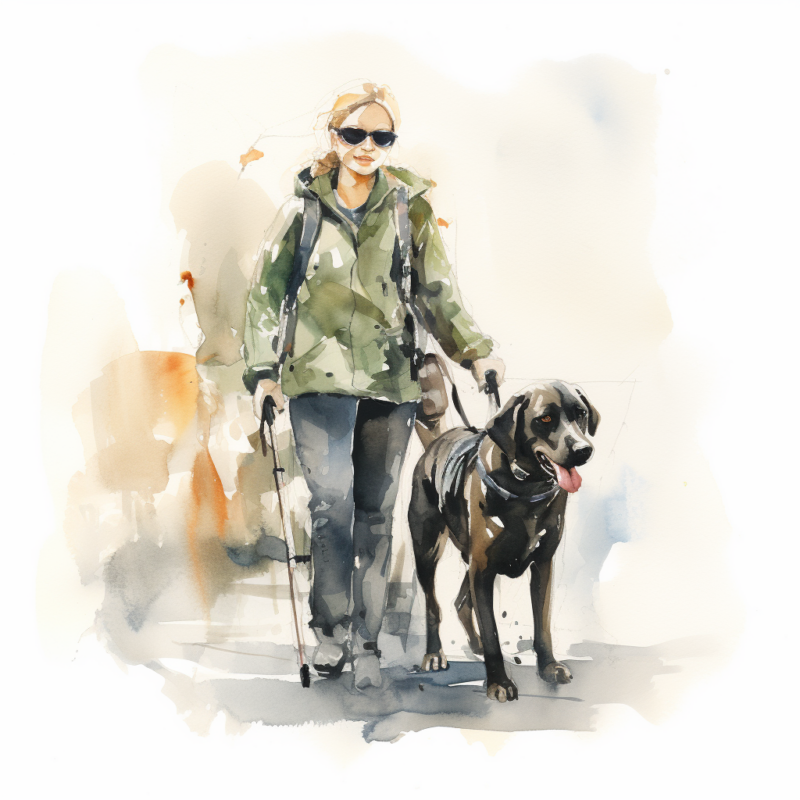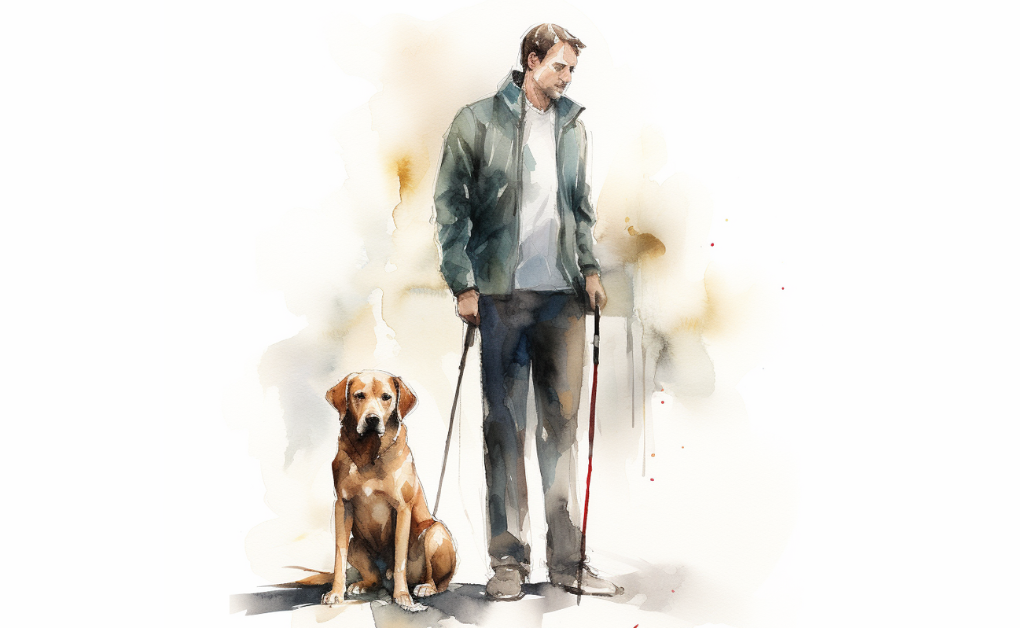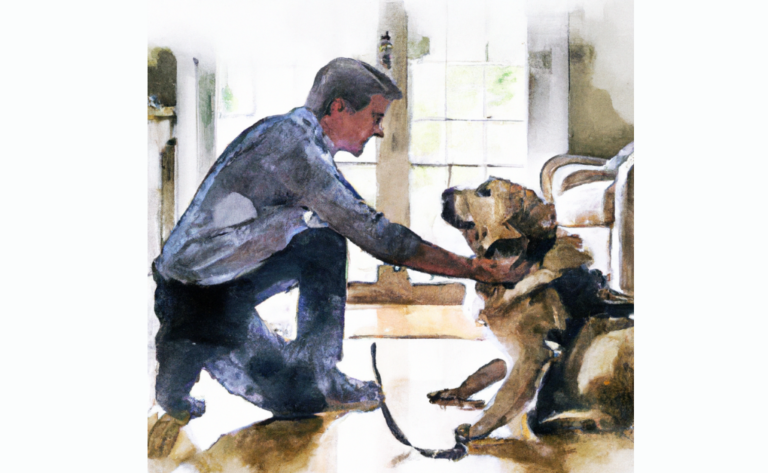How Service Dogs Can Assist in Alleviating Depression
Are you struggling with depression? If so, consider the possibility of getting a service dog. These animals are highly trained to provide emotional support and companionship and perform specific tasks, such as alerting their owners to changes in mood or behavior. Service dogs can be an invaluable source of support for those dealing with depression and may even help alleviate some of its symptoms.
What are Psychiatric Service Dogs, Emotional Support Animals, and Therapy Dogs?
A psychiatric service dog, emotional support animal, and therapy dog provide assistance and companionship to individuals, but they have different roles, functions, and legal protections. Here’s an overview of the differences:
Psychiatric Service Dog
- Trained to perform specific tasks to assist individuals with psychiatric disabilities, such as PTSD, anxiety, or depression.
- Task examples: interrupting panic attacks, providing deep pressure therapy, or reminding the owner to take medication.
- Under the Americans with Disabilities Act (ADA), these dogs have the same access rights as other service dogs, which means they can accompany their handler in public spaces where pets are typically not allowed, such as restaurants, stores, and public transportation.
Emotional Support Animal (ESA)
- Provide emotional support and comfort to individuals with mental health conditions or emotional disorders who are not trained to perform specific tasks.
- Can be any animal, not just dogs, as long as they provide the necessary emotional support to their owner.
- ESAs are not granted equal public access rights as service dogs, although they are permitted in no-pets housing under the Fair Housing Act (FHA) and the Air Carrier Access Act (ACAA). Additionally, with appropriate documentation, they may accompany their owner in the aircraft cabin during travel.
Therapy Dog
- Trained to provide comfort, affection, and emotional support to various individuals in settings such as hospitals, nursing homes, schools, or disaster relief areas.
- Not explicitly assigned to one individual but work with their handler to interact with and bring comfort to multiple people.
- Therapy dogs do not have the same legal rights as service dogs or emotional support animals. They are allowed in specific facilities and settings where they are invited or granted permission but do not have automatic public access rights.
Benefits of Having a Service Dog
Service dogs can be specifically trained to assist individuals with depression, a type of psychiatric service dog. These dogs perform various tasks and provide numerous benefits to help their handlers cope with the challenges of living with depression. Some studies and benefits include:

Grounding and Anxiety Interruption
- Service dogs can be trained to recognize signs of anxiety or panic attacks. They can respond by providing physical contact, nuzzling, or leaning against their handler to help ground them and interrupt the episode.
Tactile Stimulation
- Service dogs can offer tactile stimulation by licking their handler’s hand or face, which can have a calming effect and help redirect their focus from negative thoughts or emotions.
Deep Pressure Therapy
- Service dogs can be trained to apply deep pressure therapy by lying on their handler’s chest, lap, or legs, which can help reduce anxiety, provide comfort, and promote relaxation.
Medication Reminders
- Service dogs can be trained to remind their handlers to take their medication at specific times by bringing the medication container, nudging, or performing other alerting behaviors.
Encouraging Social Interaction
- The presence of a service dog can help reduce social isolation and encourage the handler to engage in social activities, providing opportunities for positive interaction and support.
Establishing Routines
- Service dogs require regular care, feeding, and exercise, which can help their handlers establish and maintain daily routines, contributing to improved mental health.
Emotional Support and Companionship
- The unconditional love and companionship a service dog provide can help alleviate loneliness and provide emotional support during difficult times.
Increased Physical Activity
- Service dogs need regular exercise, encouraging their handlers to engage in physical activities such as walking, helping improve mood and overall well-being.
Safety and Security
- The presence of a service dog can provide a sense of security and comfort, helping to reduce anxiety and stress for their handler.
It’s essential to note that a psychiatric service dog should be professionally trained to perform specific tasks tailored to the individual’s needs. Therefore, the functions and benefits a service dog provides for depression may vary depending on the handler’s particular requirements and the dog’s training.
Service Dogs are Trained to Perform Specific Tasks That Support Their Owner
Service dogs are trained to assist individuals with disabilities or health conditions, and the specific tasks they perform depend on the person’s needs and the type of dog. The tasks a service dog can achieve will depend on the individual’s needs and the kind of service dog. Here are some examples of tasks that service dogs can perform:
Mobility Assistance
- Retrieving dropped items
- Opening and closing doors
- Turning on/off lights
- Pulling a wheelchair
- Providing physical support and stability
Hearing Assistance
- Alerting to specific sounds, such as doorbells, alarms, or a crying baby
- Leading the handler to the source of the sound

Guide Dogs for the Visually Impaired
- Leading the handler around obstacles
- Stopping at curbs and stairs
- Navigating traffic
- Locating specific objects or places
Guide Dogs for the Visually Impaired
- Leading the handler around obstacles
- Stopping at curbs and stairs
- Navigating traffic
- Locating specific objects or places
Allergy Detection
- Sniffing out allergens in food or the environment
- Alerting the handler to the presence of allergens
Assistance During Episodes of Postural Orthostatic Tachycardia Syndrome (POTS) or Syncope
- Alerting the handler before an episode occurs
- Providing physical support to help the handler sit or lie down
- Fetching water, medication, or help during an episode
Additional Factors Must be Considered When It Comes to Service Dogs
Getting a service dog for someone with depression can effectively provide support and improve their quality of life. However, there are several factors to consider before making this decision:
- Commitment and responsibility: Owning a service dog involves a long-term commitment, typically 8-10 years or more. The owner must be prepared to provide consistent care, including feeding, grooming, exercise, and veterinary care.
- Training: A psychiatric service dog should be professionally trained to perform specific tasks tailored to the individual’s needs. The training process can be time-consuming and costly. Some individuals may choose to train their dogs with the help of a professional trainer, while others may opt for a program that provides fully trained dogs.
- Financial considerations: Owning a service dog can be expensive, including training, regular veterinary care, food, grooming, and other supplies. It’s essential to ensure that the individual can financially support the ongoing needs of a service dog.
- Lifestyle compatibility: A service dog’s energy level, size, and temperament should be compatible with the individual’s lifestyle, living situation, and activity level. For example, an active dog may not be suitable for someone with limited mobility or living in a small apartment.
- Public access rights and education: While service dogs have public access rights under the Americans with Disabilities Act (ADA), they must be aware of the legal rights and responsibilities associated with having a service dog. The owner may need to educate others, including employers, landlords, and businesses, about the role of a service dog and their legal protections.
- Support network: Having a support network of friends, family, or professionals who can provide guidance and assistance is crucial for success, especially during the initial stages of adjusting to life with a service dog.
- Time and patience: It takes time for a service dog and its handler to develop a strong bond and learn to work together effectively. Patience and persistence are crucial during this adjustment period.
- Backup plan: In case of emergencies, vacations, or illness, it’s essential to have a backup plan for the care of the service dog, such as a trusted friend, family member, or professional boarding facility.
These factors will help ensure that the individual with depression and their service dog have a successful and mutually beneficial relationship, leading to a more independent and fulfilling life.
What are the Best Service Dog Breeds?
The best service dog breeds for people with depression are intelligent, empathetic, trainable and possess a temperament that matches well with the individual’s needs and lifestyle. Here are some breeds that are commonly chosen as psychiatric service dogs for people with depression:
- Labrador Retriever: Known for their intelligence, trainability, and friendly nature, Labradors are a popular choice for various types of service dogs, including those for people with depression.
- Golden Retriever: Like Labradors, Golden Retrievers are highly trainable, intelligent, and gentle, making them well-suited for psychiatric service work.
- Standard Poodle: Poodles are known for their intelligence and versatility, and they are hypoallergenic, which can be beneficial for individuals with allergies. Their sensitive nature makes them a good match for those with depression.
- German Shepherd: These brilliant and trainable dogs can be excellent service dogs for individuals with depression when properly trained and socialized. Their loyalty and protective nature can provide a strong sense of security.
- Border Collie: Known for their high intelligence and strong work ethic, Border Collies can make excellent psychiatric service dogs for active individuals who can provide the mental and physical stimulation these dogs require.
- Boxer: Boxers are affectionate, intelligent, and trainable, making them suitable candidates for psychiatric service work. Their playful and loving nature can be beneficial for individuals with depression.
- Cavalier King Charles Spaniel: This affectionate and adaptable breed is known for its empathetic nature, making them an excellent choice for individuals who need emotional support and companionship.
- Pomeranian: Although small, Pomeranians are intelligent, trainable, and deeply devoted to their owners, making them suitable for those who prefer smaller dogs for emotional support and companionship.
- Great Dane: Despite their large size, Great Danes are known for their gentle and affectionate nature. They can provide a sense of security and comfort for individuals with depression.
- Australian Shepherd: These intelligent, energetic, and loyal dogs can make excellent psychiatric service dogs for individuals with active lifestyles who can provide the necessary mental and physical stimulation.
Cost
The cost of obtaining a service dog for people with depression can vary widely, ranging from a few thousand dollars to over $30,000, depending on factors such as the source of the dog, the type of training, and additional expenses. Costs include purchasing or adopting the dog, professional or owner-assisted training, and ongoing expenses such as food, veterinary care, grooming, and supplies.
The American Kennel Club states that specialized organizations can charge up to $25,000 for a trained service dog.
Some organizations offer financial assistance, reduced-cost, or free service dogs for qualifying individuals, helping to offset the costs associated with obtaining and maintaining a service dog. While the investment can be significant, a well-trained service dog can provide invaluable support and improve the quality of life for someone with depression.
Qualify for a Service Dog
To qualify for a service dog, an individual must meet certain criteria and follow specific steps, which may vary depending on the country and local laws. In the United States, the process typically involves the following:
- Have a documented disability: According to the Americans with Disabilities Act (ADA), a service dog is assigned to someone with a disability that substantially limits one or more major life activities. Documentation of the disability, which can encompass physical, sensory, psychiatric, intellectual, or other mental disabilities, should be provided by a medical professional such as a doctor, psychiatrist, or therapist.
- Demonstrate a need for a service dog: The individual must show that the service dog is necessary to help with specific tasks related to their disability. For example, a person with depression might require a psychiatric service dog to interrupt panic attacks, provide deep pressure therapy, or remind them to take medication.
- Ensure the dog is trained for specific tasks: A service dog should be prepared to perform tasks directly assisting the individual with their disability. The training can be done through a professional organization or by the owner with the help of a professional trainer. The dog must also be well-behaved and non-disruptive in public settings.
- Comply with local laws and regulations: Different countries, states, or cities may have specific laws or requirements for service animals. Therefore, researching and complying with local regulations is essential to avoid legal issues.
- Apply for a service dog through a reputable organization: If you choose to obtain a service dog through an organization, research and select a reputable provider specializing in the type of service dog needed. Then, complete their application process, which may involve providing medical documentation and references and participating in interviews or assessments.
- Train or obtain a suitable dog: Once you qualify for a service dog, either obtain a dog from a reputable breeder, adopt a shelter or rescue organization, or work with a professional training organization to get a fully trained service dog. Ensure the dog is adequately trained to perform the tasks needed and matches your lifestyle and needs well.
Remember that the specific steps and requirements may vary depending on the country or region and the type of service dog needed. Therefore, researching and following the relevant guidelines is essential to ensure that you qualify for a service dog and that the dog meets the necessary training and behavior standards.
How to Get a Service Dog for Depression
There are several ways to obtain a service dog, depending on your preferences, budget, and specific needs. Here are the main options:
Service Dog Organizations
Research reputable organizations that train service dogs for your specific needs to buy a service dog from an organization. Once you’ve identified an organization, complete their application process, which may involve providing medical documentation and references and participating in interviews or assessments.

If your application is accepted, the organization will match you with a suitable dog based on temperament and size. You’ll likely be required to participate in handler training to learn how to work effectively with your service dog. After completing the training program and transitioning into daily life with your new service dog, the organization may offer ongoing support and assistance to maintain a successful working relationship.
Remember that costs vary widely; some organizations may have extensive waiting lists or stringent application processes.
Private Trainers
Hiring a private trainer experienced in training service dogs is another option. You can obtain a dog from a reputable breeder or a rescue organization, and the trainer will work with you and the dog to develop the necessary skills and tasks. This option allows for more personalized training but can be costly and time-consuming.
Dog trainers employ various techniques and methods to train dogs to become service dogs. The process typically begins with selecting a suitable candidate based on temperament, intelligence, and physical attributes. Then, trainers use positive reinforcement, such as praise, treats, and toys, to teach dogs basic obedience skills and socialization in various environments.
After mastering basic commands and behaviors, the dogs are trained to perform specific tasks related to the handler’s disability, such as retrieving items, providing balance support, or alerting to sounds. Task training is often customized to the individual’s needs, and trainers work closely with the future handler to ensure effective communication and bonding.
Throughout the training process, trainers consistently assess the dog’s progress, fine-tuning skills and addressing any behavioral issues, ensuring the dog is well-behaved, non-disruptive, and fully equipped to assist their handler.
Owner Training
Some individuals train their dogs to become a service dog. Suppose the dog has the right temperament, intelligence, and physical abilities to perform the tasks needed to assist with the owner’s disability. This approach is known as owner training and can be a more affordable alternative to obtaining a service dog from an organization or private trainer.
This approach requires a significant time commitment, patience, and knowledge of training techniques. While this option can be more affordable, it may only be suitable for some, particularly those with limited experience in dog training.
Hybrid Approach
A combination of the above methods can also be used. For example, you might work with a private trainer or service dog organization for the initial training and then continue the training yourself with ongoing support from the trainer or organization.
Each method has pros and cons, and the best option will depend on factors such as your specific needs, budget, and experience with dog training. Regardless of the chosen method, it’s crucial to ensure the dog is adequately trained to perform the tasks needed to assist with your disability and to maintain a well-behaved and non-disruptive demeanor in public settings.
Qualities to Look for in a Service Dog to Help with Depression
When selecting a service dog, it’s essential to consider certain qualities that make it suitable for this type of work. Essential qualities to look for in a service dog include the following:
- Temperament: A service dog should have a calm, stable, and confident temperament. They should be able to handle stress and adapt to different environments without becoming overly anxious or aggressive.
- Intelligence: Service dogs must be intelligent and able to learn and retain new tasks quickly. They should be able to understand and respond to various commands and signals from their handler.
- Trainability: A good service dog should be eager to learn and responsive to training. They should be willing to work with their handler and be capable of focusing on tasks even in distracting environments.
- Socialization: A service dog must be well-socialized and comfortable around various people, animals, and environments. They should be able to remain calm and focused in busy public settings, such as stores, restaurants, and public transportation.
- Physical Capabilities: Depending on the tasks required, a service dog should have the necessary physical attributes to perform the tasks effectively. This can include size, strength, and endurance. For example, a mobility assistance dog should be large and robust enough to provide balance support or help their handler stand up.
- Health: A healthy service dog must ensure it can perform its tasks effectively and have a long working life. Choose a dog screened for common breed-specific health issues and maintain regular veterinary check-ups to monitor their well-being.
When selecting a service dog, it’s essential to consider these qualities and assess its suitability for the tasks needed to assist with your disability. Working with reputable breeders, trainers, or organizations can help you find a service dog with these essential qualities.
Frequently Asked Questions
Disclaimer: The information provided on this veterinary website is intended for general educational purposes only and should not be considered as a substitute for professional veterinary advice, diagnosis, or treatment. Always consult a licensed veterinarian for any concerns or questions regarding the health and well-being of your pet. This website does not claim to cover every possible situation or provide exhaustive knowledge on the subjects presented. The owners and contributors of this website are not responsible for any harm or loss that may result from the use or misuse of the information provided herein.







